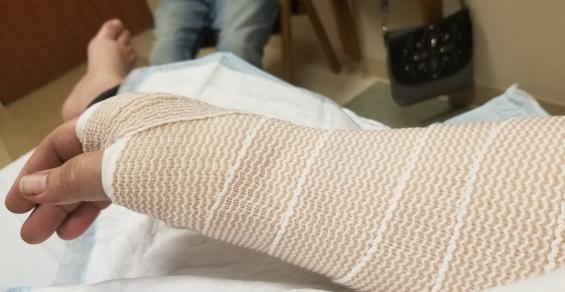Dairy Program: Understanding cow and bull behavior can prevent accidents.
I grew up on a dairy farm and have been around cattle my entire life. What started out as a normal Sunday morning milking cows quickly changed for me. I never thought that one day I would be attacked by a bull.
I have always been very observant and careful when around cattle; however, sometimes that is not enough.
Understanding cow and bull behavior can prevent many accidents because not just bulls attack. It could be a fresh cow when you get too close to her baby; even cattle that have turned into pets can attack.
When it comes to preventing injuries when working with cattle, there are three areas to consider:
preventing injuries to the worker
animal handling
reducing workplace hazards
Dr. Temple Grandin says it best, “Understanding the behavior of animals helps prevent injuries to both people and animals.” A good handler will stay calm and quiet, and avoid quick movement when handling cattle.
Extra caution should be taken when working around new calves. Most fresh cows or heifers will not want to leave the calf. Sometimes it is another cow in the herd that becomes possessive over the newborn calf and can become aggressive. If you are doing something with a newborn calf, never turn your back on the mother.
Bulls raised on the farm from birth tend to be the most dangerous, especially if they have not been properly socialized to other bulls. Most of the time, a bull will show off before attacking. They will turn sideways and show aggression. Sometimes they will make guttural sounds, keep their heads lowered and even paw at the ground. Never run from or turn your back on a bull.
When I walked into our cow yard another time, I had a bad feeling about the bull. He was showing off, and I decided I did not want to be out near him when he attacked and got me down. I started to yell and, thankfully, my husband heard me and came to my rescue. The bull backed off as soon as my husband got next to me.
Other times it could be the animal that was taken to a show or is the barn pet that becomes aggressive. When I feed calves, I like to scratch or pet their heads. This is not helping the situation. If you want to pet a young animal, try to pet them anywhere but the forehead. Never allow them to head butt you either. They think they are playing, but it could turn into a dangerous situation with the wrong person.
When working with cattle, always have an escape route. Individuals should know where the people passes are located. Do not get between the animal and a gate or solid surface. Make sure to keep floor drains and manure channels covered so you do not trip and fall if you need to move quickly away from a situation.
Trust me when I say I thought I would never have to worry about getting attacked. To this day, my heart races just a little bit faster when I have to go out to the cow yard, even though the bull is no longer around.
McCarville is the Extension agriculture educator in Green County, Wis.



